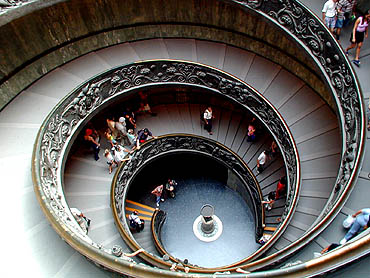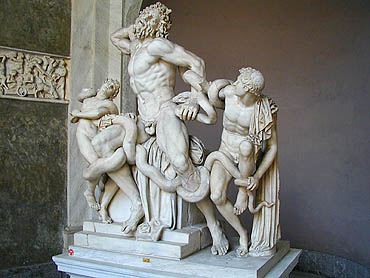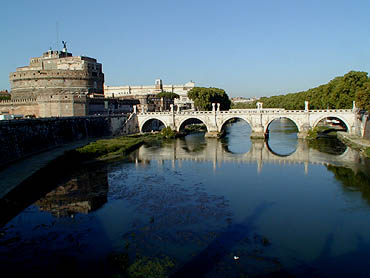

Some call this city the cesspool
of Europe. Others indulge in Rome's sensory pleasures. Rome can distress
or please her visitors like a seductive, mysterious woman. Times of struggle
and prosperity shaped her complex personality. For approximately 3,000
years, this tenacious piece of terra firma has withstood the romancing,
ravaging and redefining of Romans, popes, European armies and countless
others. The disorganized, unrivaled arrangement of contrasting structures
from antiquity to modern times reflect this frenzied history, and add to
Rome's brilliance and fascination. 
Rome seduced us with glimpses and tales of eras gone by. From a small assembly of ruins she encouraged us to study and imagine the splendor of a magnificent city and the genius of its early civilization. Across the Forum (pictured above) the voices of great orators echo through the remains of temples, stadiums, baths and public halls. You can picture triumphal parades of victorious consuls, carts loaded with spoils, shackled slaves, and legions of soldiers entering through the Arch of Titus.
At the alleged location of Caesar's funeral pyre people still leave flowers to honor the famed statesmen and general. In the Coliseum (pictured left), illusory sounds of clanking swords, masses cheering and lions roaring transport us, for a brief moment, into the bizarre spectacle of Ancient Rome's entertainment. Numerous drinking fountains throughout the city remain supplied by Roman aqueducts. On the Palatine, umbrella pines whisper the stories of Rome's incessant rape and defacement. The ghosts of three millenniums dance in her streets.
The villainy of the Roman Catholic Church unfolded upon her breast.  Many of the best preserved Roman temples (Temple of Faustina, pictured below right), including the Pantheon, could only survive as converted churches. The papal architects pillaged antique structures for materials to enrich the projects of popes. Marauding religious zealots and armies, inflamed with the blessings of the Holy See, defaced and destroyed antiquities all over the world, besides committing a myriad of other atrocities.
Many of the best preserved Roman temples (Temple of Faustina, pictured below right), including the Pantheon, could only survive as converted churches. The papal architects pillaged antique structures for materials to enrich the projects of popes. Marauding religious zealots and armies, inflamed with the blessings of the Holy See, defaced and destroyed antiquities all over the world, besides committing a myriad of other atrocities.
Rome's grandest villas are filled with priceless artwork and frescoes depicting the magnificence, power and glory of popes and their families, and exemplify a period of divine greed and arrogance. The jewels of an enormous fortune, secured in the crulest fashions and large enough to feed the world's hungry, hang around Rome's neck. The Vatican, including St. Peter's Basilica, certainly the crown jewel, vested with country status, impressed us with an unrestrained exhibit of the organization's pompous and apathetic disposition.
We did not visit Rome to judge her benefactors. We came to enjoy her beauty and history, both in abundant supply. In our opinion, the resulting art and buildings, neighborhoods and fountains, squares and villas nearly amend the means. The only real misfortune relates to the destruction of antiquities. Although we are not inclined toward organized religion, we embrace the church for its contribution to the arts.
The selfish pursuits of the popes fueled the expansion of the Renaissance awakening, and provided a vehicle for the creation of amazing art and architecture. This time period saw an unrivaled assembly of talents in Rome: Michelangelo, Raphael, Botticelli, Ghirlandio, Fra Angelico, Caravaggio, Leonard da Vinci, Bernini, Bramante, and countless other incredible artists. Famous villas, squares, stairways and churches received their designs, management and decorations. Every place of worship contains a museum.


Perhaps the greatest collaboration of genius occurred at St. Peter's Basilica and the Vatican. The living quarters of previous popes, the Sistine Chapel, library, and other assorted rooms combine to form the Vatican Museum. Our visit there left us speechless. Architectural details included a spiral stairway (pictured above left) by Bramante near the beginning of the tour, and a heliocoidal staircase (pictured above right) by Guiseppe Momo at the end. Raphael and his school painted amazing frescoes (pictured below left) in three apartment rooms of Pope Julius II. A renowned collection of antiquities featured famous Greek and Roman sculptures, including the Laocoön (pictured below right).
The recently restored Sistine Chapel frescoes by Michelangelo and other famous Renaissance masters granted an extraordinary finish. Some of the many artists involved in the design and building of St. Peter's include Bramante, Raphael, Michelangelo and Bernini. However, Bernini's extensive interior works, including the giant baldacchino, numerous sculptured tombs and the apse, form much of the building's character. He also created the large elliptical square with quadruple colonnades in front of the church. Unfortunately, Michelangelo's renowned Pieta (Deposition of Christ) sits 20 feet behind a glass window, due to tourist damages it received throughout the years.


 Rome's venue of smaller but not less significant churches comprise a complete cross section of architectural styles. Inside the various Romanesque, Renaissance, Counter Reformation and Baroque constructions, we discovered 5th century mosaics, sculptures by Bernini, paintings by Caravaggio, frescoes by Pinturicchio, and countless other artistic treasures. During these tours, we developed an appreciation for Benini's profound impact on the complexion of Rome.
Rome's venue of smaller but not less significant churches comprise a complete cross section of architectural styles. Inside the various Romanesque, Renaissance, Counter Reformation and Baroque constructions, we discovered 5th century mosaics, sculptures by Bernini, paintings by Caravaggio, frescoes by Pinturicchio, and countless other artistic treasures. During these tours, we developed an appreciation for Benini's profound impact on the complexion of Rome.
Beyond his work at St. Peter's he designed fountains, stairways, a complete baroque church and numerous other structures. His sculptures at the Villa Borghese ("Apollo and Daphne", to the right) brilliantly portray his mastery of movement, the pressure of fingers gripping soft skin, human proportions, tension and emotion. His skill for working and polishing marble infused a soul-like luminescence into the subjects. It appears that no part of Rome escaped the touch of his gifted hands and mind.
The glory of Rome exceeds the boundaries of overloaded churches. Around the Square of Spain you can shop at exclusive stores, refresh yourself with water from the fountains, or sit and relax on the Spanish Steps. In the huge park surrounding the Villa Borghese Rome's signature umbrella pines grow around a small lake, green meadows and flower gardens. Along the Tiber river, in the trendy Trastevere quarter, a one hundred year old establishment serves up delicious shaved ice concoctions filled with alcoholic or non-alcoholic flavors and topped with fresh fruit.
Rome overflows with fountains. In most squares, on many corners, and in unexpected places, an assortment of devices spew a seemingly inexhaustible water supply. Many of them, including the legendary Trevi Fountain, incorporate stunning sea horses, mermaids and sea gods, creating incredible water sculptures. Coins bound with wishes fill their basins. The Villa d'Este in Tivoli contains an astounding collection of fountains designed into a beautiful hillside garden environment. On one terrace, one hundred gargoyle-faced geysers spit streams of water simultaneously. Nearby stand the remains of the Hadrian's Villa, where we spent hot, tiring hours admiring the remains of Rome's largest ancient villa complex.
When the heat (23 days without a cloud in sight!) and long walking hours left us in an exhausted mood, we spent relaxing days sunbathing on the seaside, or swimming and sailing on a crater lake. We had divided our accommodations between a hotel in Lido Beach and a campsite on Lake Bracciano, both an easy train ride away from the center of Rome.
Rome welcomed us in her finest attire. For the celebration of Christ's 2000th birthday, churches and museums had been restored, facades painted, the whole city cleaned and decorated. Rome's hospitality surprised and delighted us. Day after day she lured us with her divine beauty, her unparalleled collection of artwork and architecture, and into her charming neighborhoods, cozy restaurants and varied landscapes. We succumbed to her seductions, accepted her superlative gifts. And fell head over heels in love with her!


Above left: Castel Sant' Angelo, living quarters of the pope; right: Trevi Fountain. Below left: Villa d'Este; right: St. Peter's Square and Basilica.

